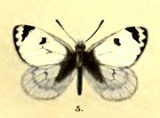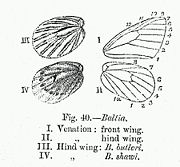
Baltia shawi
Encyclopedia
Shaw's Dwarf , Baltia shawi is a small butterfly
of the Family Pieridae
, that is, the Yellows and Whites, which is found at high altitudes in Central Asia
.
Male on upperside is pale white; base of wings irrorated with black scales. Forewing: costal margin very narrowly yellowish, costal and subcostal veins irrorated with black scales, a discocellular elongate oblique black spot; a narrowly sub-triangular short oblique pre-apical black bar, its apex downwards, and a series of inwardly triangular black spots on the termen, these narrow posteriorly and reach from the apex of wing to vein 1. Hind wing: uniform, the irroration of black scales more extended than on the fore wing.
Underside: forewing white; costa and apex irrorated with black scales, the costa and termen margined with a line of pinkish yellow; the black diseocellular spot, the black preapical bar and terminal series of black spots much as on the upperside, but the last is ill-defined, somewhat diffuse at apex and does not descend below vein 3. Hind wing: white with a dull pinkish tinge all over; the whole surface irroratod with black scales that form a broad elongate patch on posterior half of the wing and an obscure curved macular discal band beyond the cell; disco-cellulars defined with black.
 Female differs from the male as follows:—
Female differs from the male as follows:—
Upperside: somewhat thickly irrorated all over with black scales. Fore wing with the discocellular black spot and terminal series of inwardly-pointed triangular black spots as in the male, but the latter more complete, extends from apex to tornus, the spots are larger and there is no pre-apical bar, out a complete, outwardly dentate, curved discal black band that crosses the wing from costa to dorsum. Hind wing: the irroration of black scales very dense in a broad patch posteriorly, and so arranged as to form a curved macular discal band. Underside similar to that of the male, but on the fore wing there is a complete terminal series of inwardly triangular black spots and a complete, outwardly dentate, curved discal black band; while on the hind wing the irroration of black scales is denser. In both sexes the antennae are white annulated with black, the club black; head whitish; thorax and abdomen fuscous black; beneath: head and thorax fuscous black, abdomen prominently white.
Wing expanse 34-50 mm.
Recorded from the Karakoram
Mountains at an elevation of 18,000 feet; found also in the Pamirs and Tibet
.
Butterfly
A butterfly is a mainly day-flying insect of the order Lepidoptera, which includes the butterflies and moths. Like other holometabolous insects, the butterfly's life cycle consists of four parts: egg, larva, pupa and adult. Most species are diurnal. Butterflies have large, often brightly coloured...
of the Family Pieridae
Pieridae
The Pieridae are a large family of butterflies with about 76 genera containing approximately 1,100 species, mostly from tropical Africa and Asia. Most pierid butterflies are white, yellow or orange in coloration, often with black spots...
, that is, the Yellows and Whites, which is found at high altitudes in Central Asia
Central Asia
Central Asia is a core region of the Asian continent from the Caspian Sea in the west, China in the east, Afghanistan in the south, and Russia in the north...
.
Description
- See glossaryGlossary of Lepidopteran termsThis glossary describes the terms used in the formal descriptions of insect species, jargon used mostly by professionals or entomologist....
for terms used
Male on upperside is pale white; base of wings irrorated with black scales. Forewing: costal margin very narrowly yellowish, costal and subcostal veins irrorated with black scales, a discocellular elongate oblique black spot; a narrowly sub-triangular short oblique pre-apical black bar, its apex downwards, and a series of inwardly triangular black spots on the termen, these narrow posteriorly and reach from the apex of wing to vein 1. Hind wing: uniform, the irroration of black scales more extended than on the fore wing.
Underside: forewing white; costa and apex irrorated with black scales, the costa and termen margined with a line of pinkish yellow; the black diseocellular spot, the black preapical bar and terminal series of black spots much as on the upperside, but the last is ill-defined, somewhat diffuse at apex and does not descend below vein 3. Hind wing: white with a dull pinkish tinge all over; the whole surface irroratod with black scales that form a broad elongate patch on posterior half of the wing and an obscure curved macular discal band beyond the cell; disco-cellulars defined with black.

Upperside: somewhat thickly irrorated all over with black scales. Fore wing with the discocellular black spot and terminal series of inwardly-pointed triangular black spots as in the male, but the latter more complete, extends from apex to tornus, the spots are larger and there is no pre-apical bar, out a complete, outwardly dentate, curved discal black band that crosses the wing from costa to dorsum. Hind wing: the irroration of black scales very dense in a broad patch posteriorly, and so arranged as to form a curved macular discal band. Underside similar to that of the male, but on the fore wing there is a complete terminal series of inwardly triangular black spots and a complete, outwardly dentate, curved discal black band; while on the hind wing the irroration of black scales is denser. In both sexes the antennae are white annulated with black, the club black; head whitish; thorax and abdomen fuscous black; beneath: head and thorax fuscous black, abdomen prominently white.
Wing expanse 34-50 mm.
Recorded from the Karakoram
Karakoram
The Karakoram, or Karakorum , is a large mountain range spanning the borders between Pakistan, India and China, located in the regions of Gilgit-Baltistan , Ladakh , and Xinjiang region,...
Mountains at an elevation of 18,000 feet; found also in the Pamirs and Tibet
Tibet
Tibet is a plateau region in Asia, north-east of the Himalayas. It is the traditional homeland of the Tibetan people as well as some other ethnic groups such as Monpas, Qiang, and Lhobas, and is now also inhabited by considerable numbers of Han and Hui people...
.

